Fall Color Delight
Minnesota Fall Color Update
According the MN DNR, much of the state is seeing peak color right now with some spots across western and northern Minnesota already past peak!
Follow along as the fall colors change with the MN DNR map HERE:
Follow along as the fall colors change with the MN DNR map HERE:
Typical Fall Color Peak in Minnesota
Here are the typical fall color peak times across the state of Minnesota and note that areas along the northern tier of the state usually see their peak toward the 2nd half of September. However, peak color usually doesn't arrive in central Minnesota until October, but we're getting close.
Wisconsin Fall Color Update
Colors are popping in Wisconsin too! In fact, much of the state is seeing peak color right now!
See more from Travel Wisconsin HERE:

As many as 17 different wildfires continue to burn in California, which have consumed more than 221,000 acres since Sunday, October 8th. Unfortunately, the death toll is up to 36, making it the deadliest week of wildfires in the states history. The fires have reportedly consumed nearly 6,000 structures and there are still hundreds of people still missing.
Cal Fire has updates on all of the fires HERE:
"Reinforcements from other regions are helping firefighters contain more of the largest wildfires devastating Northern California, though strong winds expected over the weekend could challenge those gains, a fire chief said Friday. Meanwhile, officials are making grim discoveries -- victims burnt beyond recognition -- as they search blackened ruins of some of the 5,700 homes and business that have been destroyed. "Some of (the remains) are merely ashes and bones," Sonoma County Sheriff Rob Giordano said at a Thursday evening news conference. "And we may never get truly confirmative identification on ashes. When you're cremated, you can't get an ID."Thirty-six people have been killed since the wildfires began Sunday night, making this outbreak one of the deadliest in state history, according to the California Department of Forestry and Fire Protection (Cal Fire)."
See more from CNN HERE:
(Image Credit: CNN)
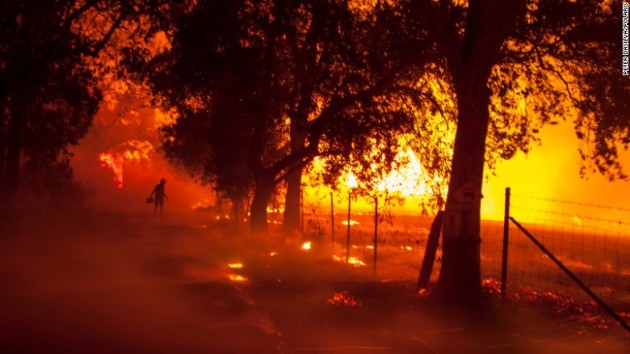
According to CAL Fire, some of the ongoing wildfires have sadly become some of the deadliest wildfires in the states history. Note the TUBBS Fire has reportedly killed 17, which is considered to the be 3rd most deadly fire in the states history.
"Jan Pascoe and her husband, John, were trapped. The world was on fire, and Jan was hyperventilating from fear. Then they remembered their neighbors’ pool. “You’ve got to calm down, Jan,” she told herself. “You can’t go underwater and hyperventilate.” At 12:40 a.m. Monday, Jan called 911. She reached a dispatcher. “We are going to get into the neighbors’ pool, should we do this?’ The dispatcher said, “Get anywhere safe.” “Please. We will be in the pool,” Jan replied. “This is where we are.” “In my naivete, all night long,” she would tell me later, “I thought someone would come to get us.” Jan, 65, and her husband, John, 70, debated when to get in. She wanted to right away, but John said, “Hold off. The water’s cold. Let’s see what happens.” As they stood at the edge of the pool, the neighbors’ house caught fire. A big tree next to the pool went up in flames. The railroad ties framing the concrete steps leading to the pool ignited. “The heat was ‘whoa,’” John said. He stripped off his pants and jacket, and wearing only a T-shirt, turned to Jan and said, “Jump in now.”"
See more from LATimes HERE:
(John and Jan Pascoe survived the firestorm Monday morning by running out of their home and into their neighbors swimming pool in Santa Rosa. Brian van der Brug / Los Angeles Times)
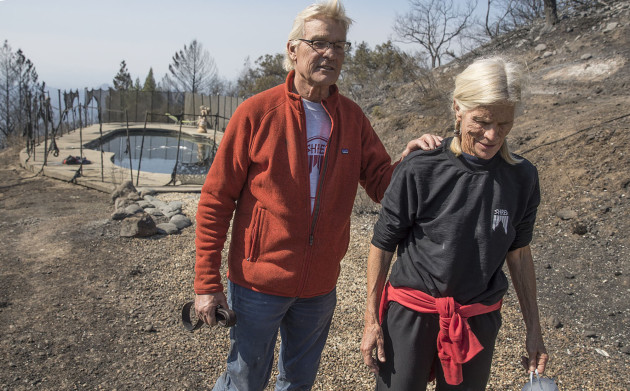
California Wildfires
There are a number of wildfires ongoing across California, many of which are located in the northern part of the state.
Ongoing Large Wildfires
Here's a look at the current wildfire map across the country. While several fires are still ongoing, recent cool and somewhat wet weather has been helping curb the wildfire threat, especially in the Western US.
Here's a list of all the current large wildfires from Inciweb:
 _________________________________________________________
_________________________________________________________
Here's a look at the current wildfire map across the country. While several fires are still ongoing, recent cool and somewhat wet weather has been helping curb the wildfire threat, especially in the Western US.
Here's a list of all the current large wildfires from Inciweb:
OPHELIA has been a pretty impressive storm way out in the northeastern part of the Atlantic. According to NOAA's NHC, OPHELIA was a category 3 hurricane with sustained winds of 115mph on Saturday morning.
.gif)
Impressive OPHELIA
According to Brenden Moses @Cyclonebiskit - who is a hurricane researcher & undergrad at NOAA's NHC - "OPHELIA has shattered the record for the northeastern-most forming Cat 3 in the Atlantic and is the easternmost overall." WOW! Pretty impressive, huh?
Here's the official track for OPHELIA, which looks like it could continue hurricane status into early next week. Note that this storm will likely impact Ireland and Scotland with very strong winds early next week as well!
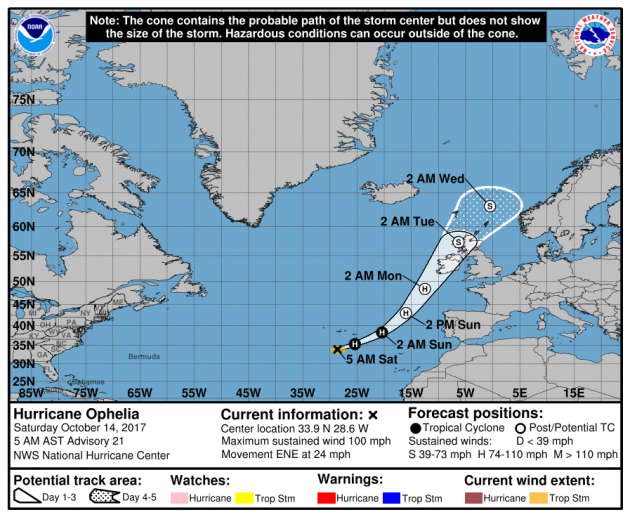
A severe weather warning have been issued as Hurricane Ophelia approaches the UK, however some areas will enjoy sunny spells before heavy rain and strong winds arrive. The Met Office has warned of 80mph winds in coastal areas, particularly in Northern Ireland, as the remnants of Hurricane Ophelia hits on Monday. But luckier parts of the UK will see temperatures rising to 25C over the weekend and escape the worst of the tropical storm on Monday. They have warned about potential power cuts, damage to buildings, flying debris and the possibility of disruption to transport and mobile phone networks. “A spell of very windy weather is likely on Monday in association with ex-Ophelia,” they said. “Road, rail, air and ferry services may be affected, with longer journeys times and cancellations possible. “Power cuts may occur, with the potential to affect other services, such as mobile phone coverage. “Some damage to buildings, such as tiles blown from roofs could happen, perhaps leading to injuries and danger to life from flying debris. “Coastal routes, sea fronts and coastal communities may be affected by spray and/or large waves.” It will coincide with the 30th anniversary of the Great Storm of 1987.
See more from Telegraph.co.uk HERE:
Here's the Atlantic outlook over the next 5 days, which shows the remnants of OPHELIA in the northeastern part of the Atlantic moving quickly toward Ireland There was also another wave of energy that had a MODERATE probability of tropical formation over the next 5 days.
.png)
__________________________________________________________
September 10th - Official Peak of the Atlantic Hurricane Season
Here's the average Atlantic hurricane season, which shows that peak activity generally occurs on September 10th and stays somewhat active through the month of October, but really diminishes through the month of November. Again, the Atlantic Hurricane Season doesn't officially end until November 30th.
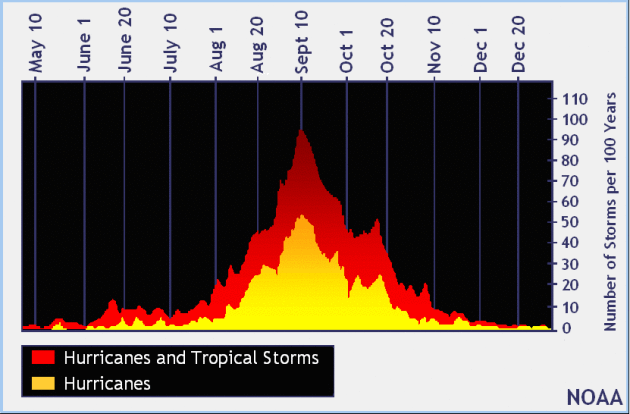
PRELIMINARY 2017 Tornado Map
It certainly has been a fairly active first half of 2017 with 1,433 preliminary tornado reports through October 6th. Note that this is the most tornadoes through that date since 2011, when there were 1,815 reports. The map below shows the distribution of the tornadoes so far this year.
 PRELIMINARY 2017 Tornado Count
PRELIMINARY 2017 Tornado Count
According to NOAA's SPC, the PRELIMINARY 2017 tornado count is 1,433 (through October 13th). Note that is the most active year for tornadoes since 2011, when there were 1,815 tornadoes. Keep in mind there was a major tornado outbreak in the Gulf Coast region from April 25-28, 2011 that spawned nearly 500 tornadoes, some of which were deadly. That outbreak is known as the Super Outbreak of 2011 and has gone down in history as one of the biggest, costliest and one of the deadliest tornado outbreaks in history.
.png)
_____________________________________________________________________
According to NOAA's SPC, the PRELIMINARY 2017 tornado count is 1,433 (through October 13th). Note that is the most active year for tornadoes since 2011, when there were 1,815 tornadoes. Keep in mind there was a major tornado outbreak in the Gulf Coast region from April 25-28, 2011 that spawned nearly 500 tornadoes, some of which were deadly. That outbreak is known as the Super Outbreak of 2011 and has gone down in history as one of the biggest, costliest and one of the deadliest tornado outbreaks in history.
.png)
_____________________________________________________________________
2.) Heavy rain for the coastal Pacific Northwest and northern California, Tue-Fri, Oct 17-20.
3.) Heavy snow for the higher elevations of the Cascades, Wed-Fri, Oct 18-20.
4.) Heavy snow for parts of the Northern Rockies, Bitterroots, and Columbia Plateau Thu-Fri, Oct 19-20.
5.) Heavy rain for parts of western Washington and western Oregon, Sat-Sun, Oct 21-22.
6.) Heavy snow for parts of the Cascades, Bitterroots, Columbia Plateau, and Northern Rockies, Sat-Sun, Oct 21-22.
7.) Flooding occurring along the St. Johns and Withlacoochee Rivers across central Florida.
Flooding possible for part of southern Texas.
8.) Severe drought across parts of the northern Rockies, northern and central Great Plains, Midwest, and Hawaii.
.png)
October Moisture in Montana
Thanks to a number of storm system, parts of Montana continue to pick up much needed moisture. Here's a look at the estimated precipitation since the beginning of October, which suggests some 1" to near 2" tallies for some! While it's not drought busting rain, it is drought denting... keep it coming!
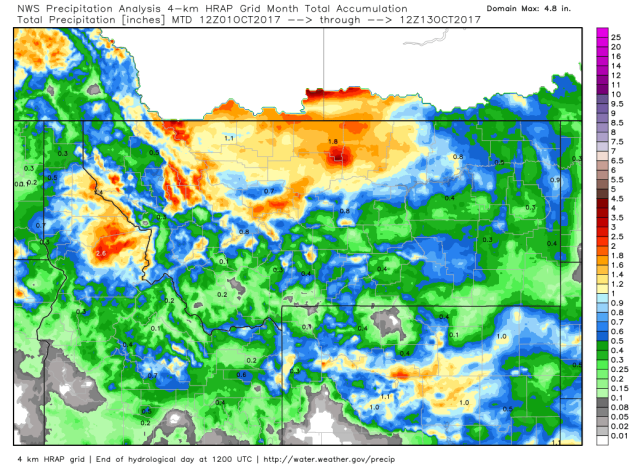
Here's the latest drought update from the US Drought Monitor, which shows EXCEPTIONAL drought conditions continuing across parts of Montana. Note that nearly 90% of the state is considered to be abnormally dry, but the EXCEPTIONAL drought covers nearly 5% of the state, which is down from nearly 10% from last week. We're also seeing some improvement in the EXTREME drought, which is nearly 18% this week, down from near 23% last week.
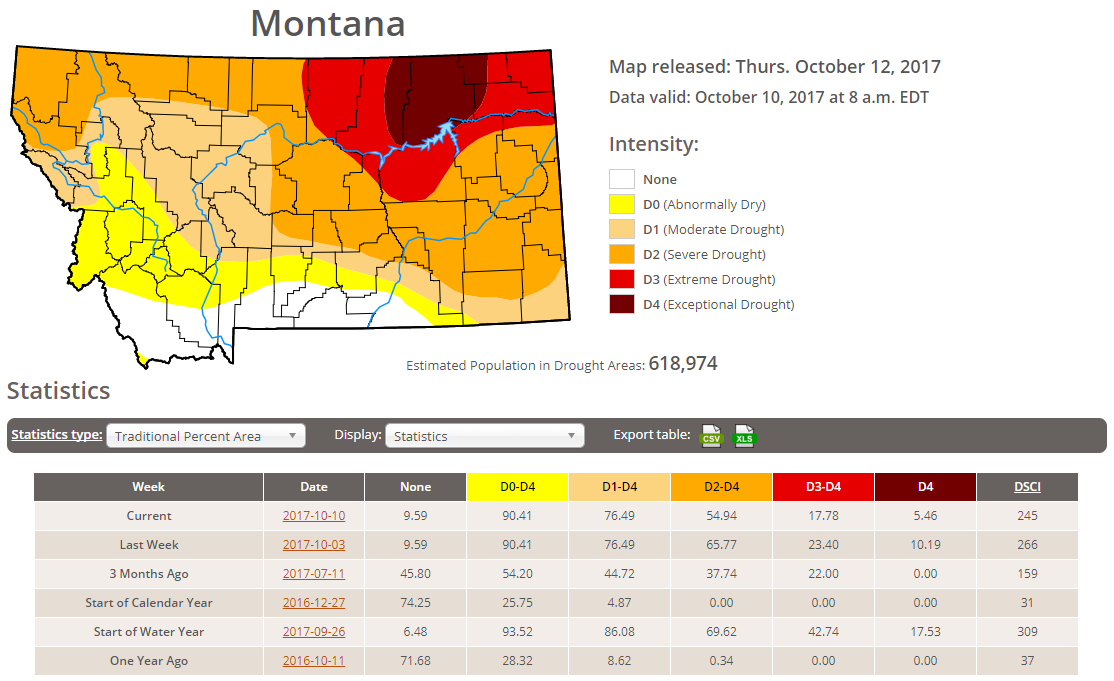
Rain Needed to End Drought
Thanks to recent cool and wetter weather, drought conditions have been improving, but we still need nearly 4" to 10"+ to end the drought in these locations.
High Temps Sunday
Here's a look at high temperatures across the nation on Sunday, which suggests that temperatures in the eastern third of the country will be nearly 5F to 15F above average ahead of a cool front. However, behind the front, temperatures will drop to 5F to 15F below average for much of the Central US.
National Weather Outlook
Here's the weather outlook through the early part of next week, which shows a fairly large storm system moving through the central and eastern part of the country. The center of the storm will track through the Great Lakes on Sunday with widespread rain and gusty winds.

5 Day Precipitation Outlook
According to NOAA's WPC, areas of heavy rain will continue across parts of the Great lakes on Sunday with some 1" to 2"+ tallies. Also note that some locations across Florida could see 1" to near 2" tallies as well. The heaviest precipitaiton over the next 5 day look to be found in the Pacific Northwest, where several inches of liquid could fall across the high elevations there.
 Snowy Scenes - Big Sky, Montana
Snowy Scenes - Big Sky, Montana


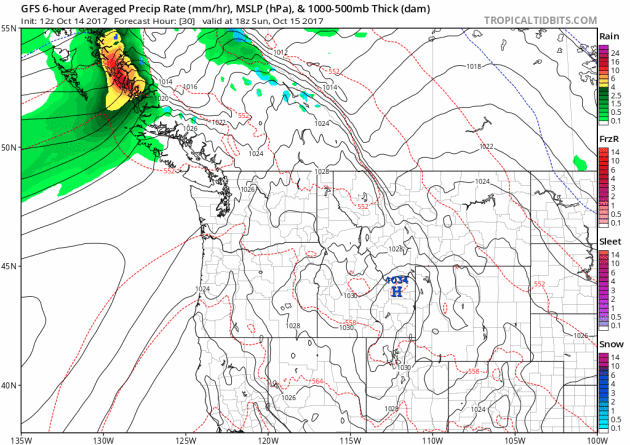

 Snowy Scenes - Big Sky, Montana
Snowy Scenes - Big Sky, Montana
WOW - pretty view from Big Sky, Mountain, where recents snows have left the region blanketed in white.
Snow Depth
Over the last several weeks, there have been several bouts of snow in the Northwestern part of the country and it's still on the ground. Here's the lastest snow depth map, which shows some of the greatest amounts in the higher elevations.
Snowfall Potential
Here's the simulated radar from Sunday to Tuesday, which shows fairly quiet weather conditions across the central and northern Rockies through early next week. However, there is another storm system that will bring heavy rain, wind and a little more mountain snow to parts of Canada and Washington as we head into early next week.

Snowfall Potential
Here's the snowfall potential over the next 5 days, which shows the heaviest snow falling across parts of Canada

________________________________________________________________________
One of the Best Weeks of Fall Shaping Up
By Paul Douglas
By Paul Douglas
"Some people feel the rain — others just get wet" mused Roger Miller. My back teeth are floating, and no wonder. The first half of October will rank as one of the wettest on record for much of the state.
Even before last night's deluge 4-7 inches of rain had soaked southern Minnesota since October 1. According to my friend and climate guru Mark Seeley it's part of a trend. "16 of the past 22 Octobers have been wetter than normal on a statewide basis, with 3 among the top 5 wettest historically." Seeley adds the corn and soybean harvest has been delayed, but soil is being recharged for next spring's crops.
Sunday morning's atmosphere is almost cold enough for a few wet snowflakes, but skies should clear behind a colder front. A dry week is on tap for Minnesota as temperatures mellow into the 60s; 70s expected the latter half of the week. Good timing with MEA Weekend and a 4-day weekend.
What a fall: a parade of catastrophic Atlantic hurricanes; now historic wildfires scorching California, with the greatest risk in the L.A. area today. No whining about our wimpy cool front OK?
________________________________________________________________________
Extended Forecast
SUNDAY: Wet start, slow clearing. Winds: NW 8-13. High: 54
SUNDAY NIGHT: Partly cloudy and cool. Winds: W 5. Low: 36
MONDAY: Chilly start, fine finish. Bright sun. Winds: SW 7-12. High: 61
TUESDAY: Sunny and pleasant. Winds: SW 7-12. Wake-up: 45. High: 69
WEDNESDAY: Partly sunny. A Septemberlike breeze. Winds: NW 10-15. Wake-up: 52. High: 71
THURSDAY: Mild sunshine. Too nice to work. Winnds: S 7-12. Wake-up: 50. High: 70.
FRIDAY: Blue sky. Hints of late summer. Winds: S 10-20. Wake-up: 57. High: 73.
MONDAY: Chilly start, fine finish. Bright sun. Winds: SW 7-12. High: 61
TUESDAY: Sunny and pleasant. Winds: SW 7-12. Wake-up: 45. High: 69
WEDNESDAY: Partly sunny. A Septemberlike breeze. Winds: NW 10-15. Wake-up: 52. High: 71
THURSDAY: Mild sunshine. Too nice to work. Winnds: S 7-12. Wake-up: 50. High: 70.
FRIDAY: Blue sky. Hints of late summer. Winds: S 10-20. Wake-up: 57. High: 73.
SATURDAY: Partly sunny. Warm enough for shorts. Winds: S 15-25. Wake-up: 60. High: 75.
_______________________________________________________
_______________________________________________________
This Day in Weather History
October 15th
October 15th
1968: Unseasonably warm weather moves into central and southern Minnesota. The high was 85 in the Twin Cities.
1899: Heavy rain falls, with 3.2 inches in the St. Cloud area and 2.1 inches in Willmar.
________________________________________________________
________________________________________________________
Average High/Low for Minneapolis
October 15th
October 15th
Average High: 59F (Record: 85F set in 1968)
Average Low: 40F (Record: 21F set in 1876)
Average Low: 40F (Record: 21F set in 1876)
Record Rainfall: 1.24" set in 1966
Record Snowfall: 0.3" set in 1992
_________________________________________________________
Record Snowfall: 0.3" set in 1992
_________________________________________________________
Sunrise/Sunset Times for Minneapolis
October 15th
October 15th
Sunrise: 7:29am
Sunset: 6:28pm
Sunset: 6:28pm
Hours of Daylight: ~10 hours 58 mins
Daylight LOST since yesterday: ~3 minutes and 1 seconds
Daylight LOST since summer solstice (June 20th): 4 hours & 39 minutes
__________________________________________________________
Daylight LOST since summer solstice (June 20th): 4 hours & 39 minutes
__________________________________________________________
Moon Phase for October 14th at Midnight
2.8 Days After Last Quarter Moon
2.8 Days After Last Quarter Moon

_________________________
Weather Outlook For Sunday
Temps on Sunday will be quite chilly in the wake of a storm system that brough widespread rain to the region Saturday/Saturday night. Much of Minnesota will be nearly 5F to 10F BELOW average

__________________________________________________________________________
Simulated Radar Ahead...
Here's the simulated radar across the Upper Midwest from Sunday into early next week, which suggests mostly quiet weather in the wake of the storm system that brought widespread rain to the region late Saturday/Saturday night. It appears that much of next week will be dry with very mild temps for mid October.
.gif)
______________________________________________________
Minneapolis Temperature Outlook
Here's the temperature outlook through October 29th, which shows chilly temps lingering on Sunday, but look how warm it gets next week! The 3rd full week of October could feature readings in the 60s and 70s, which 10F to almost 15F above average! Enjoy it because the extended forecast suggests MUCH cooler temperatures potential moving in by the end of the month. Stay tuned.

_________________________________________________________________
Crop Update
"Continued soggy field conditions further delayed soybean harvest, which was still lagging behind the 5-year average pace, and hampered the corn for grain harvest during the week ending October 8, 2017, according to USDA’s National Agricultural Statistics Service. There were only 2.3 days suitable for fieldwork, the least number of days since the 1.7 days during the week ending April 30. Despite wet conditions sunflower harvest got underway. Harvest continued for corn silage, dry beans, potatoes, and sugarbeets."
October Rainfall So Far...
It's been a fairly wet month so far with many areas seeing 2" to nearly 4" of rain, but a few locations have seen 4" to 7" in southern Minnesota!

According to the US Drought Monitor, much of the state is drought free, but nearly 11% of the state is considered to be abnormally dry with 1.3% in a Moderate drought, which is down from nearly 2.5% last week.
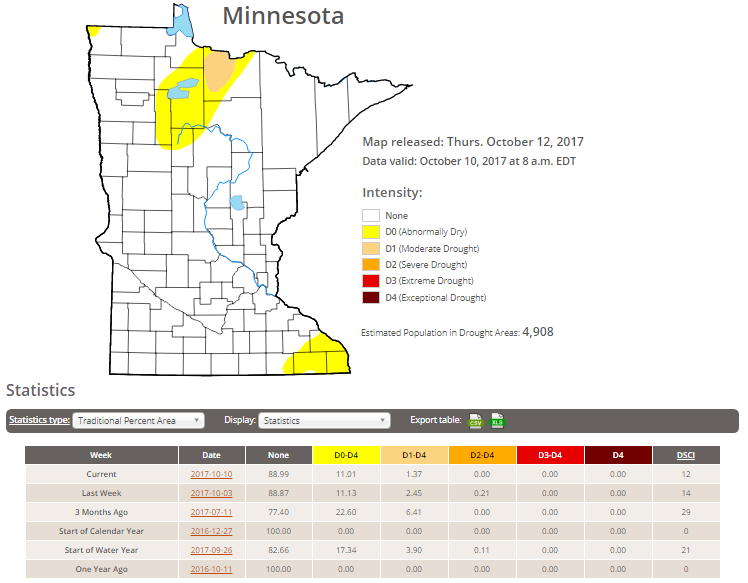
_____________________________________________________________________
"Climate conditions behind deadly October 2017 wildfires in California"
"Under the driving force of fierce winds, deadly wildfires exploded across northern California in the second week of October 2017. According to the Los Angeles Times, at least 17 people had been killed as of October 11, and thousands of homes and other infrastructure—including cell phone towers used by the state’s emergency services—had been destroyed. The extremely dangerous fire conditions actually began last winter, with near-record precipitation between December 2016-February 2017. The drought-busting amounts of precipitation re-stocked the state’s snowpack, which had been heavily depleted by 6 years of drought. The wet winter fostered “megablooms” of desert wildflowers and ushered in a lush growing season. Unfortunately, the climate swung to a different extreme. The state’s second-wettest winter on record was followed by its hottest summer. Baked to tinder in the extreme heat, the abundant vegetation of spring became the kindling for these autumn fires."
______________________________________________________________________
"U.S. warmer and drier than average in September; 3rd warmest and wettest year to date"
Nation experienced 6 billion-dollar weather disasters since June. Though September was warmer and drier than average for the U.S, it will long be remembered for the devastating impacts from Hurricanes Irma and Maria, as well as the remnants of Harvey, to southern parts of the U.S. and the Caribbean. Billion-Dollar Weather and Climate Disaster Update Since June 2017, six additional weather and climate events impacted the nation with costs exceeding $1 billion. These new events included western U.S. wildfires, Northern Plains drought, severe weather in the Midwest, and major hurricanes Harvey, Irma and Maria. This brings the year to date total to 15 separate billion-dollar weather and climate disasters, tying 2011 for the record number of events for this period. Cost estimates associated with the 2017 hurricanes will be available in January 2018.

________________________________________________________________
"30th Anniversary of the 1987 Storm"
"While the ‘Great Storm’ of 15 and 16 October 1987 is still one of the most talked about weather events in living memory it was also a wake-up call for the Met Office and other organisations. It helped identify gaps in severe weather forecasting capability and highlighted the need for better communication with partner organisations such as emergency services and the public in general. Bringing wind gusts in excess of 100 mph the storm resulted in the loss of 22 lives, around £1 billion worth of damage and there was widespread disruption across southern England. It has gone down in history as one of the worst UK storms since 1703 and will obviously be remembered for Michael Fish’s now famous television broadcast. Over the last 30 years there have been many major developments and changes in the way weather forecasts are produced. There have also been changes in how they are communicated and therefore in how people respond."
See more from MetOffice.gov HERE:
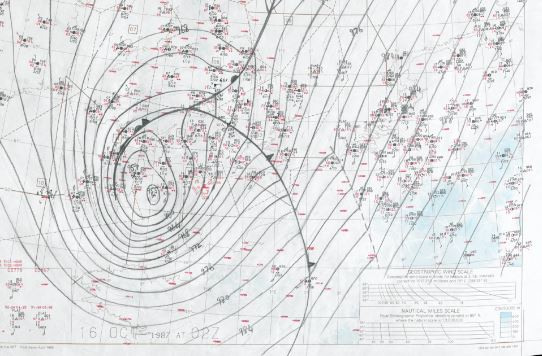
___________________________________________________________________"Satellite Quantifies Carbon Dioxide from Coal-Fired Power Plants"
"Using data from NASA’s Orbiting Carbon Observatory 2 satellite, researchers measured emissions of the greenhouse gas from individual coal plants in the United States, India, and South Africa. Despite the increasing popularity of renewable energies like wind and solar power, countries around the world continue to build power plants fueled by coal. Now, researchers have analyzed satellite observations of plants in three countries to test whether the space-based measurements can accurately reveal how much carbon dioxide (CO2) such plants emit. The scientists found that their measurements were consistent to within 17% of reported values, although the satellite they used was not designed for this sort of reconnaissance. NASA built the satellite, called the Orbiting Carbon Observatory 2 (OCO-2), to quantify naturally occurring CO2over large spatial scales, said Ray Nassar, an atmospheric scientist at Environment and Climate Change Canada in Toronto and leader of the team that analyzed the data."
See more from Earth & Space Science News HERE:
(Credit: kamilpetran/iStock/Getty Images Plus Via Earth & Space Science News)

______________________________________________________________________"This Surprising Sea Creature Is Causing Climate Change"
"Clams and worms at the bottom of the ocean may be releasing "ridiculous amounts of greenhouse gases" that contribute to climate change, according to a new study. Researchers behind the study, published in the journal Scientific Reports, found that 10% of the methane emissions from the Baltic Sea come from clams and worms. That's roughly equivalent to 20,000 cows. Methane is one of the most potent greenhouse gases, roughly 30 times more effective at trapping heat in the atmosphere than carbon dioxide. The study evaluated the Baltic Sea specifically, but if that effect also occurs the globe the impact of ocean clams and worms to global warming would be significant. Study co-author Stefano Bonaglia of Stockholm University said the "small animals in the seafloor may act like cows in a stable.""
See more from Time.com HERE:
(Image Credit: NOAA)
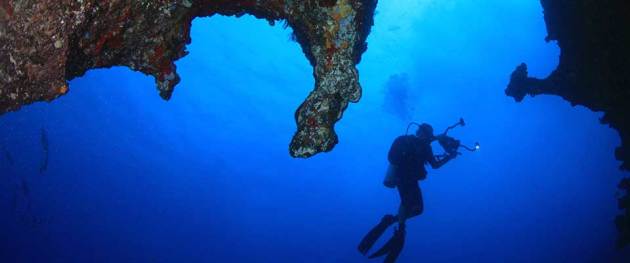
_____________________________________________________________________"Here's What We Know about Wildfires and Climate Change"
"Scientists think that global warming may already be influencing fire seasons. As deadly wildfires rage across California's wine country, leaving at least 29 dead and a trail of destruction in their wake, the influence of climate change is again being questioned. Just Monday, Hillary Clinton delivered a speech at the University of California, Davis, in which she noted that "it's been a tough couple of weeks with hurricanes and earthquakes and now these terrible fires" (Climatewire, Oct. 12). "So in addition to expressing our sympathy, we need to really come together to try to work to prevent and mitigate, and that starts with acknowledging climate change and the role that it plays in exacerbating such events," she added."
See more from Scientific American HERE:
(Credit: David McNew Getty Images Via Scientific American)
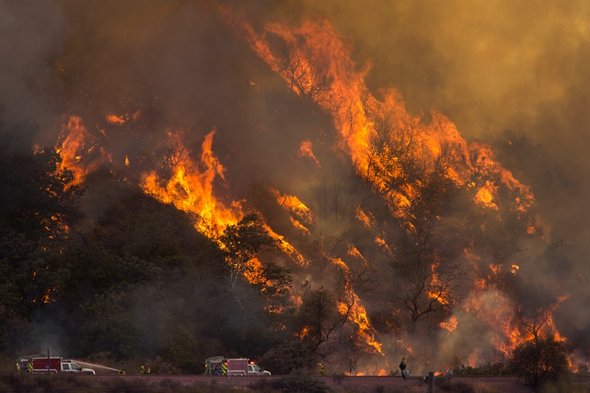
______________________________________________________________________
See more from MetOffice.gov HERE:
___________________________________________________________________"Satellite Quantifies Carbon Dioxide from Coal-Fired Power Plants"
"Using data from NASA’s Orbiting Carbon Observatory 2 satellite, researchers measured emissions of the greenhouse gas from individual coal plants in the United States, India, and South Africa. Despite the increasing popularity of renewable energies like wind and solar power, countries around the world continue to build power plants fueled by coal. Now, researchers have analyzed satellite observations of plants in three countries to test whether the space-based measurements can accurately reveal how much carbon dioxide (CO2) such plants emit. The scientists found that their measurements were consistent to within 17% of reported values, although the satellite they used was not designed for this sort of reconnaissance. NASA built the satellite, called the Orbiting Carbon Observatory 2 (OCO-2), to quantify naturally occurring CO2over large spatial scales, said Ray Nassar, an atmospheric scientist at Environment and Climate Change Canada in Toronto and leader of the team that analyzed the data."
See more from Earth & Space Science News HERE:
(Credit: kamilpetran/iStock/Getty Images Plus Via Earth & Space Science News)

______________________________________________________________________"This Surprising Sea Creature Is Causing Climate Change"
"Clams and worms at the bottom of the ocean may be releasing "ridiculous amounts of greenhouse gases" that contribute to climate change, according to a new study. Researchers behind the study, published in the journal Scientific Reports, found that 10% of the methane emissions from the Baltic Sea come from clams and worms. That's roughly equivalent to 20,000 cows. Methane is one of the most potent greenhouse gases, roughly 30 times more effective at trapping heat in the atmosphere than carbon dioxide. The study evaluated the Baltic Sea specifically, but if that effect also occurs the globe the impact of ocean clams and worms to global warming would be significant. Study co-author Stefano Bonaglia of Stockholm University said the "small animals in the seafloor may act like cows in a stable.""
See more from Time.com HERE:
(Image Credit: NOAA)

_____________________________________________________________________"Here's What We Know about Wildfires and Climate Change"
"Scientists think that global warming may already be influencing fire seasons. As deadly wildfires rage across California's wine country, leaving at least 29 dead and a trail of destruction in their wake, the influence of climate change is again being questioned. Just Monday, Hillary Clinton delivered a speech at the University of California, Davis, in which she noted that "it's been a tough couple of weeks with hurricanes and earthquakes and now these terrible fires" (Climatewire, Oct. 12). "So in addition to expressing our sympathy, we need to really come together to try to work to prevent and mitigate, and that starts with acknowledging climate change and the role that it plays in exacerbating such events," she added."
See more from Scientific American HERE:
(Credit: David McNew Getty Images Via Scientific American)

______________________________________________________________________

No comments:
Post a Comment